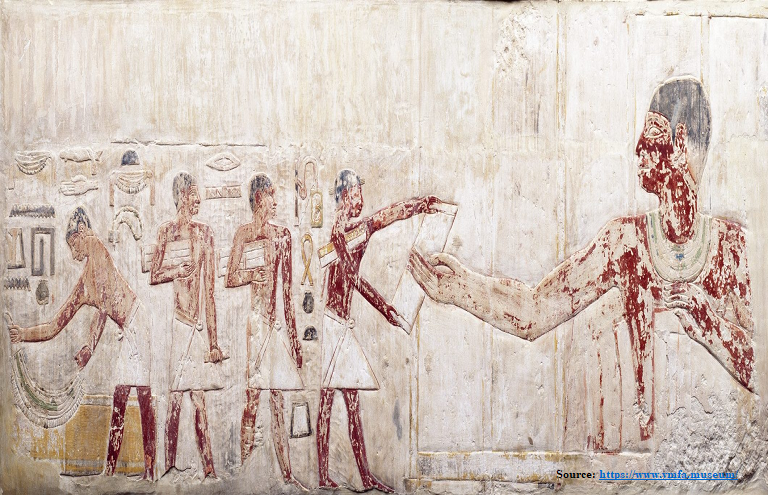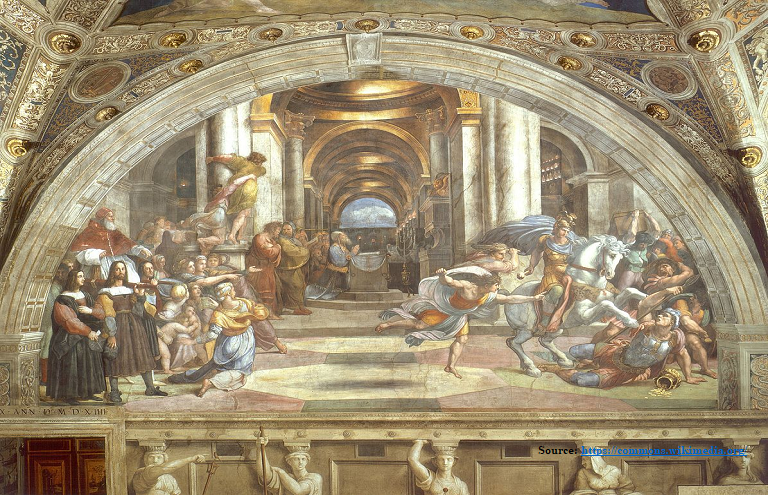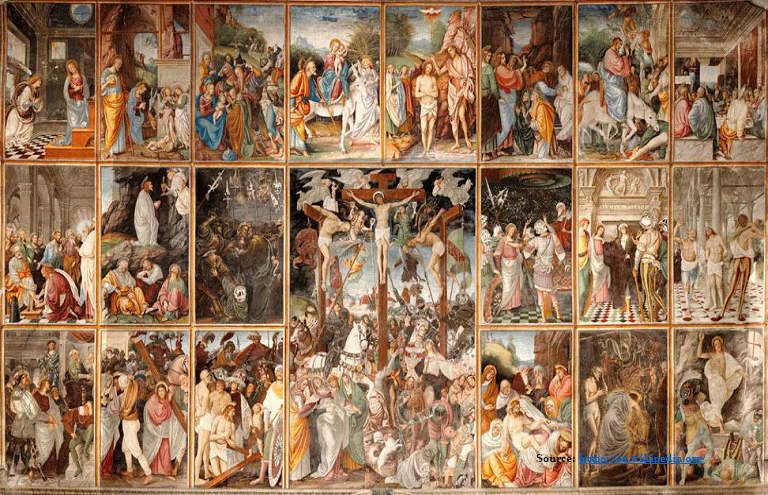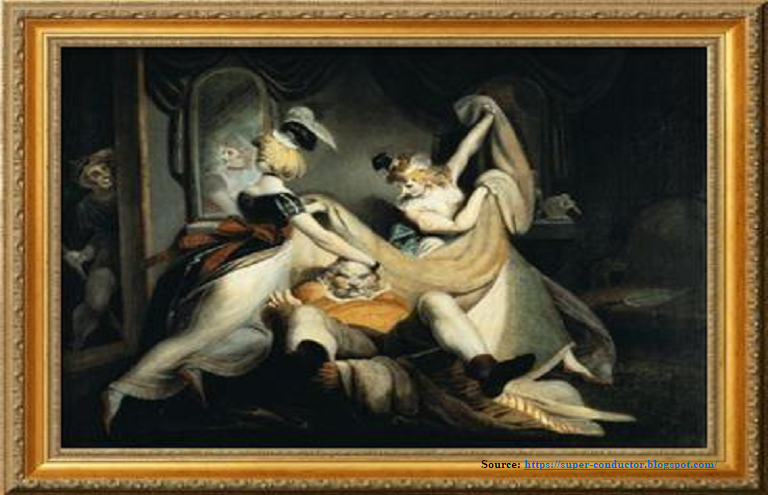
Since the beginning of civilization, humans have used images to tell their stories. The carved stone relief (image above) dates back to 2475-2195 BC features a large figure ‘Methethy’, who is giving orders to four servants (depicted smaller in size) carrying inventory of his possessions. This story painting is in accordance with the conventions of the ancient authoritarian culture wherein the most important and powerful figures, whether gods or humans, are depicted as larger than nonentity such as servants, common people.
The Meaning
Have you ever seen a picture that told a story? That's what story painting does, narrating a story either as a moment in an ongoing story or as a sequence of events unfolding over time.
Also known as narratives, story painting belongs to the genre of narrative art. It often depicts images from culture, traditions, religion, mythology, history, literature, or everyday life. The artworks can be small canvases or large wall-size images created using varied media having precise, bold brushstrokes or large swirls of paint. In fact, story painting is not about a painting style, but it rather deals with the content of the image. Whatever be the subject, story paintings contain elements of realism, that is recognizable as structures or figures in the real world.
Like every artform, narrative uses the power of the visual image to ignite imaginations, evoke emotions and portray culture, traditions, religious sentiments and societal norms. However, what distinguishes it from other artforms is its ability to narrate a story across diverse cultures and eras, preserving it for future generations.
To understand better, let’s take an example of a portrait of a woman sitting serenely against a backdrop. Is this painting a compelling narrative? When considering whether or not something is narrative, ask yourself this question: what is going to happen next? Does the image give you a hint at a sequence of events? Perhaps you can look for what happened before the scene was captured on the canvas, or suggestions of what might happen after the moment was unfolded before you by the painting.
Have you ever thought about why we tell stories? The deeper we dig into the past, the more politically engaged these narratives become. The great historical narratives were created in order to maintain the power of the ruling class, to instruct and articulate the masses, and keep a record to inform the future generations. In fact, the aristocrats employed painters rather than writers to tell their stories for them. One of the main reasons why narratives were painted is the large number of illiterate people in the ancient times. But apart from that, it is also the unique power of images to instantly translate a message. This form of art easily conveyed the messages of power, compassion, fear, alluding a sense of compliance and discipline in the viewer.
History & Evolution
Most of the visual narratives depend on the time of their creation and the cultural context. Different civilizations pursued diverse modes of speech to depict stories from their religion, scriptures, history, and literature. Ancient Romans used the particular architectural format intended to be read as a book, a triumphal column which was an exhaustive and direct interpretation of book chapters. The most famous narrative is Trajan's column. Having a cylindrical form it has an engraved story that literally revolves around the column, starting from the bottom and continuing towards the top like a spiral tracing its circumference and height.
In the following centuries, narratives were gradually modified into simpler versions wherein painters and sculptors aimed to make artworks that tell the entire story in a single glance. During the Renaissance period, the narrative was emphasized by the artist’s technical tactics who now focused on the use of light and shadow, choice of a medium, etc. Now, the story paintings would sometimes depict the protagonist(s) or segments of events in several different phases in a successive manner. However, most art done during this dynamic era of Renaissance was for the church or for religious purposes, such as The Expulsion of Heliodorus the Temple (image below) by Italian Renaissance Raphael Heliodorus was painted between 1511 and 1512, which is a fresco created on a wall by working directly in wet plaster. This story painting illustrating a biblical episode symbolizes the expulsion of the French and the subjugation of all the enemies of the church. The scene depicts a young man named Heliodorus who was sent by the king of Syria Seleucus, to take over the treasure preserved in the temple of Jerusalem. At the request of the Church priest Onias (seen praying), God sends a knight along with two heavenly angels who banish Heliodorus. The commissioning pontiff has himself shown as witnessing the scene seated in the gestatorial chair, carried on the shoulders of the chair bearers. Quite an intriguing painting, raises several questions in mind: What will happen next? Will Helidorus be trampled?

One of the most famous examples of story paintings portraying simultaneous events is the Italian cycle of the Life of Christ (image below) with 21 scenes from Annunciation to Resurrection. The top row narrates Annunciation, Nativity, Visit of the Three Magi, Flight to Egypt, Baptism of Christ, Raising of Lazarus, Entry to Jerusalem, Last Supper. Middle row: Washing of feet, Agony in the Garden, Arrest of Christ, Trial before the Sanhedrin, Trial before Pilate, Flagellation. Bottom row: Ecce homo, Carrying the cross, Christ falls, Crucifixion, Deposition from the cross, Harrowing of Hell, Resurrection.

However, the most typical story paintings made in post-Renaissance depicted a single scene, composed in an elaborate and detailed manner, yet often non-objective. One such painting of this period is Liberty Leading the People (image below) by Eugene Delacroix which represents the events that marked the Three Glorious Days of the July Revolution in France. This story painting is filled with dense and semi-chaotic content but has a positive message. The central motif is an allegory of liberty, depicted as a dominant woman leading the masses; the other characters stand for a class of people belonging to different social and economic status who we all benefit from the revolution.

Another popular story painting worth mentioning is Falstaff in the Laundry Basket (image below) painted by Henri Fuseli in 1792. Famous for his dark and mysterious images, often in dream-like states, including nightmares, he has narrated a scene from Shakespeare's play The Merry Wives of Windsor. The image portrays two women who have just convinced a character named Falstaff to hide in a basket of dirty laundry. Falstaff can be seen sprawling among the clothes as the women quickly cover him with more. Another person's face peaks around the corner, and one of the women smiles back at him. It makes us curious to know if Falstaff is in trouble? However, this narrative art has a comic twist as the laundry basket later gets dumped into the dirty river.

In the later centuries, narrative art was not only limited to story painting depicting history. The emergence of the Reformist church and the reinforcement of genre painting that followed were major contributors to the diversified plethora of narrative art wherein telling the anecdotes of ordinary people and their everyday life became one of the main subjects of European art.
Oil-on-panel work The Fight Between Carnival and Lent (image below) painted by Pieter Bruegel the Elder in 1559 depicts a common festival of the period, as celebrated in the Southern Netherlands. It represents the contrast between two sides of contemporary life, as can be seen by the appearance of the inn on the left side (for enjoyment) and the church on the right side (for religious observance). The busy scene depicts well-behaved children near the church and a beer drinking scene near the inn with a carousing character on a barrel. At the centre is a well, showing the coming together of different sections of the community, and other scenes show a fish stall and two competing floats. This story painting is the illustration of the belief that human activities are motivated by folly and self-seeking.

This type of story painting narrating the common man and their lives remains popular even today. Depicting the little things and joyful daily activities of people has always been modestly uplifting!





















